 |
 |
 |
| |
Efficacy and safety profile of APTIVUS oral solution or capsules co-administered with low dose ritonavir (APTIVUS/r) in treatment experienced children and teenagers after two years of treatment (Phase I/IIa study)
|
| |
| |
Reported by Jules Levin
IAC Mexico City Aug 3-8 2008
JC Salazar1,2, P Cahn3, C Giaquinto4, R Yogev1,5, J Mikl6, A Jelaska6
1PACTG1051 study team; 2Connecticut Children's Medical Center, Hartford, CT, USA; 3Fundaci—n HuŽsped, Buenos Aires, Argentina;
4Azienda Ospedaliera di Padova, Padova, Italy; 5Children's Memorial Hospital, Northwestern University Medical School, Chicago, IL, USA;
6Boehringer Ingelheim Pharmaceuticals, Inc., 900 Ridgebury Rd, Ridgefield, CT, USA
AUTHOR DISCUSSION
Sustained virological and immunological responses were seen over two years of
TPV/r therapy in treatment experienced children aged 2-18 years.
Younger children experienced superior virological and immunological responses
throughout the two year follow up period. This correlates with the difference in
baseline resistance status between the age groups.
The safety profile of TPV/r was unchanged with long-term therapy.
TPV/r is a potent and well-tolerated ARV for long-term treatment of pediatric patients infected with HIV-1.
ABSTRACT
Background: Analysis of 2 year follow up of an open label, international study of investigational APTIVUS oral solution (OS) co-administered with low dose ritonavir (APTIVUS/r) in children. Analysis was performed by age group and
formulation (OS vs. capsules). All patients are now being treated with high dose APTIVUS/r (375/150 mg/m2) plus optimized background regimen.
Results: 78 patients (24 2 to <6 years; 26 6 to <12 years; 11 12-18 years) entered a long-term safety and efficacy study. 50 patients completed >100 weeks of therapy. Median changes in virological and immunological outcomes from
baseline to Week 100 are shown in Table 1. At Week 100, 24.1%-56% of patients achieved VL <400 copies/mL; 20.7%-48% patients achieved <50 copies/mL. Virological responses were similar, regardless of formulation.
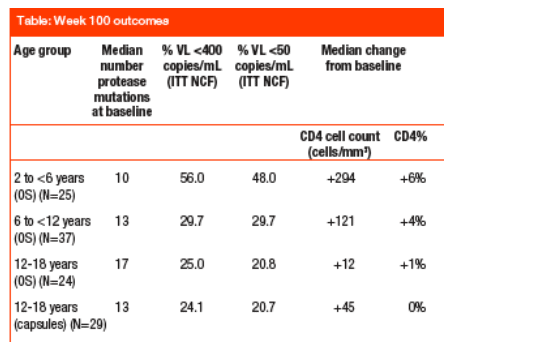
GI events were the most frequently reported AEs; the majority was mild. 28.7% of patients experienced serious AEs, over 100 weeks of follow up, mostly infections resulting in hospitalization. 13.9% discontinued APTIVUS/r because of AEs. Nine patients (8%) had Grade 3/4 ALT increase; 6 of them were aged 12-18 years. Two patients died; neither death was considered study drug-related.
Conclusions: Sustained virological and immunological responses were seen over two years of APTIVUS/r therapy in treatment experienced children aged 2-18 years. The safety profile of APTIVUS/r was unchanged with long-term therapy. APTIVUS/r (375/150 mg/m2 dose) is an effective and well-tolerated ARV for pediatric patients.
INTRODUCTION
Treatment options for HIV infected children infected with PI resistant virus are urgently needed. Tipranavir/r (TPV/r) has been approved in the USA and Europe, as well as in several other countries, for use in highly treatment experienced adult patients infected with HIV-1. TPV inhibits the replication of HIV variants harboring multiple PI-associated resistance mutations. TPV is available as a soft-gelatin capsule. An oral solution of TPV has been developed for use in pediatric patients.
Trial PACTG1051/ BI1182.14, conducted in collaboration with the PACTG, was a Phase I/IIa, open label, randomized study. It evaluated the safety, tolerability, pharmacokinetics, and antiviral activity of TPV oral solution in combination with low dose ritonavir at two dosage levels (290/115 mg/m2 and 375/150 mg/m2) in 115 ARV-naive and -experienced pediatric patients aged 2-18 years infected with HIV-11,2. TPV/r was administered as capsules or oral solution. Assignment of
formulation was not by randomization but by age and body surface area (BSA). All children started with TPV OS while individuals older than 12 years and whose BSA-based dose equaled 500/200 mg were allowed to switch to capsules after
four weeks of treatment.
Over one third of patients achieved VL <50 copies/mL at Week 48: 34.5% (20/58) of low dose patients and 35.1% (20/57) of high dose patients. At Week 48, CD4% values had increased by 5% and 3% (LOCF, as treated), respectively.
TPV/r was effective in all three age groups in terms of virological responses. TPV/r treatment was safe and well tolerated in this pediatric population with a safety profile similar to that seen in adult studies.
After 48 weeks, 78 patients participated in an Optional Safety Extension (OSE) of Trial PACTG1051/ BI1182.14. Following the analysis of the study results at Week 48, the high dose APTIVUS/r (375/150 mg/m2) was selected as the preferred
dose for the OSE1, 2. Patients also took an optimized background regimen (OBR); changes in this regimen were not allowed during the study. In this poster, we report pediatric efficacy and safety data obtained during more than two years
of treatment with TPV/r.
METHODS
Patients
Follow up efficacy and safety data up to 100 weeks from patients who had participated in Trial PACTG1051/ BI1182.14 were analyzed. The following efficacy endpoints were assessed:
-- Proportion of patients reaching a viral load (VL) reduction of ≥1 log10 copies/mL at Week 100 with no confirmatory second consecutive measurement required;
-- Proportion of patients reaching and maintaining a VL <400 copies/mL at Week 100;
-- Proportion of patients reaching and maintaining a VL <50 copies/mL at Week 100;
-- Change in CD4+ cell count and CD4+% from baseline to Week 100.
The TRUGENE genotyping assay was used to determine baseline HIV resistance.
The following safety endpoints were evaluated:
-- Incidence of adverse events (AEs) and serious adverse events (SAEs);
-- Proportion of patients reporting AEs and SAEs, by severity and action taken with regard to study medication;
-- AEs leading to premature discontinuation of study
medication;
· Specialized analyses for liver enzyme (ALT/AST) parameters.
Statistical analyses
Descriptive statistics were used to summarize and evaluate the Week 100 safety and virologic parameters. The analyses were stratified by age (2 to <6, 6 to <12, and 12-18 years of age). Since only patients in the 12-18 years age group were
able to switch from TPV OS to capsules, only data from this group could be evaluated by TPV/r formulation. For the safety analyses, the proportions of patients experiencing AEs, SAEs, and laboratory abnormalities were evaluated.
RESULTS
Baseline characteristics
Twenty five (21.7%) patients aged 2 to <6 years; 37 (33.0%) aged 6 to <12 years; and 53 (45.2%) aged 12 to 18 years entered the study. With the exception of the youngest patients, the number of patients randomized to the TPV/r low and high dose groups within each of the age categories was identical. Among the 2 to <6 year old patients, 13 and 12 patients were randomized to TPV/r low and high dose, respectively.
The overall median baseline VL was 4.7 log10 copies/mL (4.9 log10 copies/mL in the low dose group and 4.7 log10 copies/mL in the high dose group). Baseline
virological parameters were comparable between the two treatment groups and between the age cohorts.
As expected, the older patients had had more ARV experience than the younger ones. The median number of prior ARVs was three in the 2 to <6 age group; eight in the 6 to <12 age group and 10 in the 12 to 18 age group. The number of prior ARVs taken was similar, both between the two TPV/r dose groups and within each of the age groups.
Samples were available for genotypic analysis for all 115 randomized patients. Overall, there was a median of 13 protease gene mutations in the HIV isolates: 10 in the 2 to <6 age group; 13 in the 6 to <12 age group; and 17 in the 12 to 18 age group who took the OS and 13 in patients in this age group who took capsules (Table 1). The majority of the patients, 68.0%, (17/25) in the 2 to <6 age group had ˛12 mutations, compared to 47.4% (18/38) in the 6 to <12 age group and 30.8% (16/52) in the 12 to 18 age group. There were no significant differences in baseline genotype mutations between the dose groups overall or within each age group. Overall, 49.6% (57/115) of patients had HIV isolates that were resistant to all PIs tested.
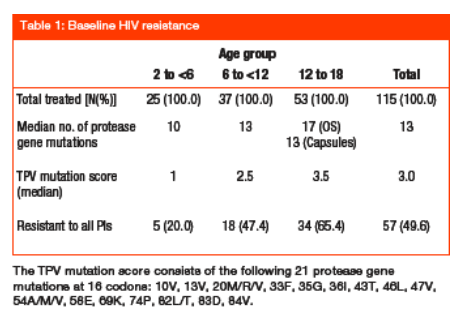
High levels of resistance were identified for NRTIs: >80% of isolates showed resistance to ddC (82.6%, 95/115), abacavir (81.7%, 94/115), d4T (80.9%, 93/115) and zidovudine (80.9%, 93/115). Approximately 70% of isolates were resistant to NNRTIs.
Patient disposition
Figure 1 depicts the patient disposition through Week 100. A total of 50 patients (40 in the oral solution group and 10 in the capsule group) completed ≥100 weeks of treatment. With the exception of one patient, all of the patients in the two younger age groups received TPV OS, but only the 12 to 18 year old group received both OS and capsule formulations.
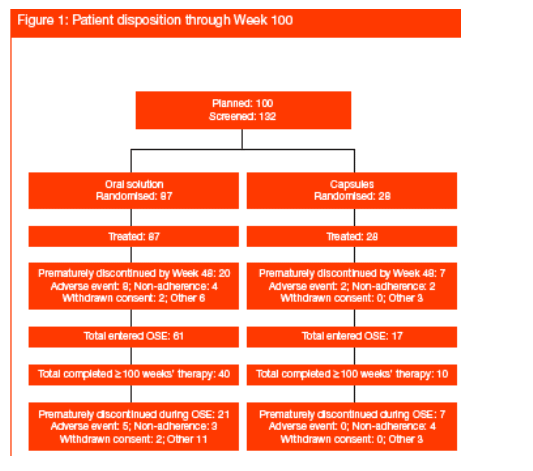
Virological and immunological outcomes
Median changes in virological and immunological outcomes from baseline to Week 100 are shown in Table 2.
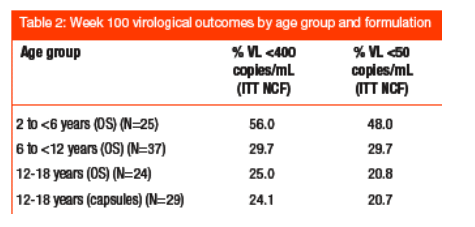
Age related differences in virological efficacy over 100 weeks of follow up were observed (Table 2). The 2 to <6 year olds experienced a median HIV VL reduction of 2.7 log10 copies/mL after 100 weeks of TPV OS treatment, compared with a median reduction of 1.2 log10 copies/mL among the
6 to <12 year olds at the same timepoint. At Week 100, the median HIV VL reduction in teenagers (12 to 18 years) was 0.2 log10 copies/mL in those taking OS and 0.4 log10 copies/mL in those taking capsules.
Among the patients <12 years of age, the youngest (2 to <6 year olds) experienced the highest response rate for all three virological response endpoints at Weeks 48 and 100. More than half (56%) of the youngest patients (2 to <6) experienced ≥1 log10 copies/mL VL reduction at Week 100. In contrast, the 6 to <12 year olds, also treated with TPV OS, had a more modest level of virologic response. By Week 100, 35% of these patients demonstrated a sustained VL reduction of ≥1 log10 copies/mL. The superior virological responses, (VL <400 copies/mL and VL <50 copies/mL), in children aged 2 to<6 years compared with those 6 to <12 years old (all treated with TPV OS) were observed throughout the treatment period.
Virological responses were similar, regardless of the TPV formulation used, in the older patients. By 100 weeks, 24% of patients aged 12 to 18 years old taking TPV capsules and 25% of those taking OS still maintained a VL reduction ≥1 log10 copies/mL. Similar results were observed for the VL <400 copies/mL and <50 copies/mL endpoints (Figure 2). For example, at Week 100, 20.8% patients aged 12 to 18 years who took OS and 20.7% who took capsules achieved a VL <50 copies/mL (ITT NCF).
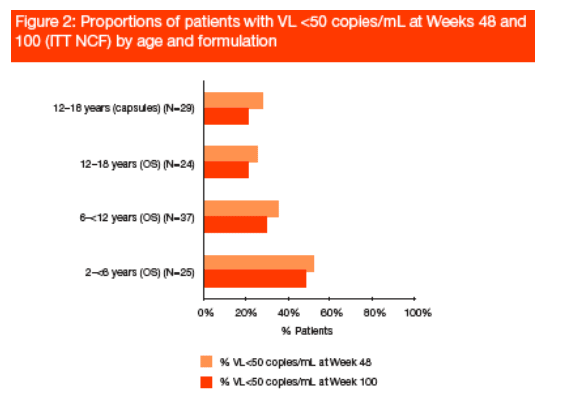
Immunological responses, stratified by age group, in the TPV OS treated patients aged 2 to <12 years indicated that the median CD4+ cell count gain from baseline was at least twofold higher among the youngest (2 to <6 years) patients when compared to the 6 to <12 year olds (Figure 3). Approximate median gains of 300 versus 120 cells/mm3 at Week 100, respectively, were observed. Similar results were observed for gain in CD4%: the highest CD4+% increase (6-7%) was observed among the youngest patients (2 to <6 years) from a median baseline value of 26%, followed by the 6 to <12 year olds (gain of 4-5% from a baseline of 19%).
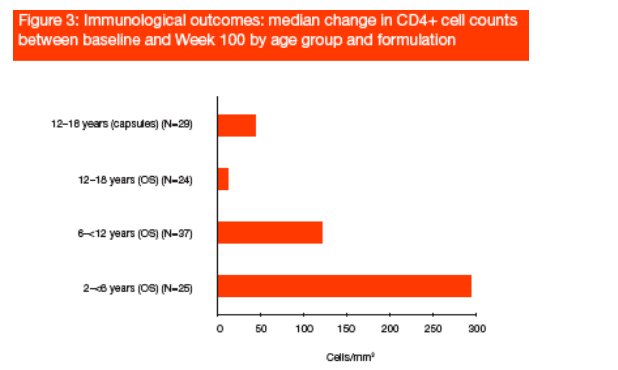
Safety
Data from 115 patients were included in the safety analysis, which used a different cut off date from the efficacy analysis. Twenty five patients were in the 2 to <6 year age group; 37 in the 6 to <12 year age group; as well as 24 who took OS and 29 who took capsules in the 12 to 18 age group. Sixty of the 115 patients included in the safety analysis had received study medication for ≥100 weeks; the majority of whom had taken OS (48/60 took OS; 12/60 took capsules). Overall, the 115 patients were treated for a total of 179.2 patient
exposure years (PEY).
The safety profile of TPV/r at Week 100 was similar to that at Week 48 (Table 3). There were no substantial differences between TPV OS and capsules in terms of their safety profiles.
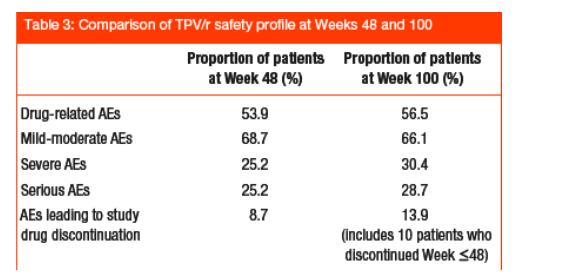
Gastro intestinal (GI) events were the most frequently reported AEs; the majority of these events were mild. There were no cases of severe vomiting (0, 0%) and only one case of severe diarrhea (1, 2.3%) during the follow up period.
Just over one quarter (28.7%) of patients experienced serious AEs over 100 weeks of follow up; these were mostly infections that resulted in hospitalization. Nine patients (8%) had a Grade 3/4 ALT increase; six of these patients were
aged 12-18 years; eight of these cases occurred before Week 48 and one occurred between Week 48 and Week 100.
Only 13.9% of children discontinued APTIVUS/r because of AEs during the 100 week follow up period. Two patients died between Week 48 and 100; neither death was considered to be study drug-related.
Overall, both the TPV/r OS and SEDDS formulations were well tolerated in a pediatric population of patients aged 2-18 years after 100 weeks of treatment. The Week 100 safety analysis revealed a safety profile that was comparable
with that reported at Week 48. No new safety concerns emerged with during TPV/r therapy for up to two years.
REFERENCES
1. Salazar, J., et al. Efficacy and safety results of 48 weeks of treatment with APTIVUS oral solution co-administered with low dose ritonavir (APTIVUS/r) in children and teenagers (Phase I/IIa study). In XVI International AIDS Conference.
2006. Toronto, Canada. Ab. WEAB0301.
2. Salazar, J., et al. Predictors of Response to TPV/r in Pediatric Patients: Results of PACTG1051/BI1182.14. In 14th CROI. 2007. Los Angeles, USA. Abs. 733
|
| |
|
 |
 |
|
|